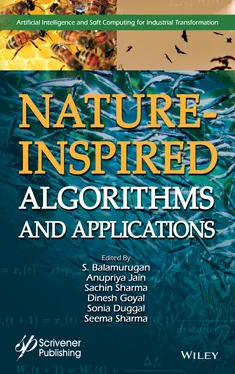1.5.1.4.6 Particle Swarm Optimization
PSO is introduced Kennedy and Eberhart in 1995 aspired by the behavior of social creatures in gatherings, for example, flying creature and fish schooling or subterranean ant colonies. This algorithm imitates the communication between individuals to share data. PSO has been applied to various fields for development and in coordination with other existent calculations.
Swarm optimization (PSO) is a strategy of computational which reduces an issue by regularly and attempting to expand an individual answer based on a specified value of proportion. This understands an issue by the way of having a populace of individual response which is named particles here, and particles move around the space of searching as per the normal statistical principle from the particle’s location and promptness. The development of each particle is attacked by its near most popular location but, at the similar period, is guided toward the most popular situations by the seeking environment that is restored with correct location that is sorted by particles of different types.
PSO will make not maximum or no presumptions about the advanced issue and that can stare over massive spaces of individual solutions. Nonetheless, metaheuristic algorithm like PSO will not ensure an ideal solution at all times. Additionally, PSO will not utilize the changing of the issue that is improved and implies that PSO will not impose that the issue of optimization can be differentiated as it is required by strategies of classical development.
Its applications include combination with a back engendering calculation, to prepare a neural system framework structure, multi-target optimization, classification, image clustering and image clustering, image processing, automated applications, dynamic, pattern recognition, image segmentation, robotic applications, time frequency analysis, decision-making, simulation, and identification.
Harmony Search (HS) is an approach inspired through the standards of the performer act of harmony. The HS has the distinctive parameters of algorithm that has efficiency in simplicity and search. During the current years, it has been effectively utilized in field such as mechanical structure design, optimization of data classification systems, function optimization, and pipe network optimization. The utilized memory of harmony is significant as it is similar to the result of the best-fit people in GA. This results in the assurance of the best harmonies that will be continued by the new memory of harmony. When performers form the harmony normally attempt different potential mixtures of the music contributes put away their memory. This search for the ideal harmony is without an uncertainty of similar to the technique of finding the ideal answers for building issues. The HS strategy is really motivated by the working standards of the harmony inventiveness. In the HS algorithm, enhancement of constrain by the pitch through modification and randomization as there are two subcomponents for modification which may be a significant feature for the maximum productivity of the HS technique.
The initial subcomponent of forming “new music” or creating new measures through the technique of randomization it would be in any event at a similar degree through productivity as various types of algorithm by randomization. An extra subcomponent by use of HS augmentation is the change of pitch. Pitch changing is completed by modifying the contribution of given data transfer capacity by a little arbitrary sum comparative with the present pitch along with the arrangement from the memory of harmony. Mainly, altering of pitch is a technique based on fine tuning practice of neighborhood activities. Consideration of memory and changing of pitch will assure as the neighborhood activities are detained with the technique of randomization and contract consideration of memory that will consider the worldwide space of inquiry in an effective manner.
The establishment is characterized in the HS algorithm through the technique of memory tolerating rate of harmony. A high amicability response rate implies the great explanation from the past, and recollection is bound to be chosen or acquired. This is identical in a specific way of exclusiveness. When the rate of acknowledgment is excessively low, the activities will meet all the activities with maximum progress. The HS algorithm is simpler to execution. The proof to recommendation of HS will decrease the impatient to the parameters that are selected, in which it implies that it will not need adjustment of the parameters to reach the high quality activities. Besides, the HS algorithm is an approach of populace based meta-heuristic that implies various sounds of gatherings and that can be utilized in equal. Appropriate parallelism generally prompts better implantation with higher proficiency. The mixture of parallelism along the elitism just as an equalization of heightening as well as enhancement is the path into the achievement of the HS algorithm and to accomplishment of few approach of metaheuristic. The stochastic subordinates give the choice probabilities of certain discrete factors during the advancement technique of the HS. It is effective at controlling discrete advancement issues and has been utilized in the ideal plan of systems of fluid transport.
In the global best HS (GHS), the alteration of new arrangements is spontaneous as it just founded on the best selected harmony from the HM without the inclusion of the distance bandwidth (BW). This fascinating methodology includes the one of a kind social learning ability to the GHS. The examination of the experiment to 10 benchmark capacities demonstrates that the GHS can perform maximum than HS. The application of the HSA is power systems, power systems, transportation, medical science and robotics, industry and signal, and image processing.
1.5.1.4.8 Social Cognitive Optimization
Social cognitive optimization (SCO) is one of metaheuristic populace-based algorithms for optimization. The algorithm of SCO is the most current perceptive algorithm. The SCO algorithm depends on the theory of social cognitive. The key purpose of the ergodicity which means the ensemble average and time average are equal that is utilized in the procedure of individual learning of a lot of specialists with their own memory and their social learning with the information focuses in the collection of social sharing. It has been utilized for solving problems of optimization which is continuous and combinatorial.
The SCO algorithm is simple with minimum number of parameters and without the changed activity as in genetic-based EA. By contrasting SCO and GA experimentally on the function of benchmark, we are able to get solution with high quality and less time for evaluation. Besides, as in human culture, one learning specialist makes performance with appropriate library size that illustration adaptability is more than in SI. The SCO algorithm can assist the solvers with avoiding stumbling in local optimization while solving the problems of nonlinear restraints. Adjusted and upgraded situations of locality that looks through and acquires the Chaos and Kent functions of mapping to contract increasingly with reasonable information are uniformly distributed [8].
In the method optimization, the algorithm is an approach of high-speed calculation and is applied to the big scale problems that are having multimodal work in optimization worldwide. The speed and the nature of outcome which are the best goals are enhanced than the methods in traditional. The algorithm will contribute to the PC by solving few problems of nonlinear with complex constraints, but regularly trips in the nearby ideal setting, and with cycle of long processing and limits the moderate union rate that extends some of these techniques. The disadvantages are it gets that the social cognitive theory that is applied in the field of the constraint that presents a SCO to take care of the nonlinear constraints. In the SCO algorithm, the procedures that are impersonation and erudition are the most significant idea to characterize the algorithm, and utilization of the procedure of the community is looking to restore the information in which the point is one of the most significant parts. In the SCO algorithm, the area looking through utilizes the irregular capacity to create area of the new information point; however, the subjective capacity depends on the straight congruently strategy. This technique is anything but difficult is that appreciates and has a long processing cycle, and the ergodicity is frail on the off chance that we utilize this strategy and the information point might be a long way from the essential problem and has the likelihood to pass the best goals. In this way, it is important to adjust and improve the social cognitive theory and the SCO algorithm. The area looking of standard SCO algorithm depends on the basic irregular capacity and the ergodicity of basic arbitrary is feeble that can affect the looking through scale of uneven and the recent information point that can have a long way from the essential idea.
Читать дальше












